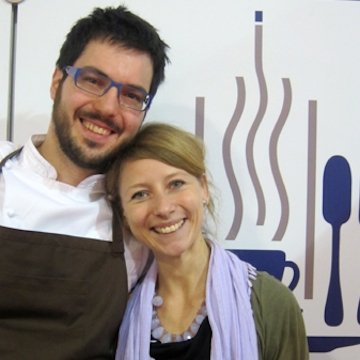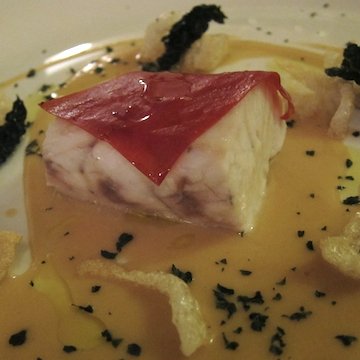Fabrizio is a popular name. Ferrari is even more so, among surnames. Ironically, there are two starred chefs who are called this way, one who has worked in Bergamo for a long time, the other always in Lecco. And it’s about the latter one I’d like to write. The son of two restaurateurs from Lecco with a passion for the sea, hence the seafood restaurant in a town by a lake, Fabrizio represents a rare, almost unique example. Born in 1980, he was only four when his parents opened the Porticciolo. It was 1984 and this explains why the date is mentioned in the restaurant’s sign: Porticciolo 1984, even though a plaque on top of the entrance says Al Porticciolo 84, tel. +39.0341.498103, Via Fausto Valsecchi 5 is the address, a road going uphill, in the direction of the mountains, not of the lake.

Fabrizio Ferrari and Anna Valsecchi, together in work and life
Here’s how things went for him:
Fabrizio studies, graduates in law and finds a first job in London. He then works in Milan, with computers, and finally his third job brings him straight back to the family restaurant. Still young, he was 23 when the 2004 edition was published, an important one since it meant the debut of the
Porticciolo in the starred heaven.
Very few chefs in the world, not only in Italy, can boast such an important goal at such an early age. Except few people noticed it, frankly speaking - including me. Lecco never amplified the news, almost as if the cuisine of the Ferrari family didn’t belong to them. After all, they serve seafood dishes in a town by a lake (and the Lario lake too, which has never been brilliant when it came to cuisine) and the mountain tops of Grigna and Resegone.
It’s not only a question of raw materials per se, and of an evidently inexistent tradition. It’s also a matter of style, of ideas. As classic as the seafood proposed by his parents (his mother cooked, his father is still in the dining room with his daughter-in-law Anna Valsecchi), with raw materials of the highest quality used according to tradition, as with the chargrilled fish, the cuisine of their son looks at the future and at the whole world. An internship at Uliassi, then Redzepi and Noma, in a while perhaps in the United Kingdom. In fact, there’s nothing in common with the roots of his parents if not the sea.

Steamed ombrina fish, red lentils, black cabbages, chicharrones, tomato leather, a dish by Fabrizio Ferrari ofPorticciolo 1984 in Lecco
And it is at this point that problems arise, with two worlds in one. Last week, a friend who’s a culinary fan, was mentioning a place as the best restaurant for seafood in Milan. I reminded him of another one and he replied “Great place, but they serve
piattini”. A few years ago he would have recalled
nouvelle cuisine. Here, at the
Porticciolo, roasted and chargrilled fish, a mix of raw fish and perhaps even
spaghetti allo scoglio live together with a signature cuisine that would have gained much more visibility, had it been made elsewhere. The first world doesn’t scare anyone off and most people enjoy it because this is how it’s all been, always and everywhere. For the second one, instead, you need dedication, you need to be in harmony with the person who has created it and take the necessary time to fully enjoy it. When you’re a rush, you take the car, you don’t stroll under the sun.
1. to be continued